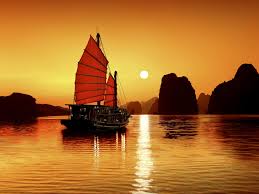Inle Lake
Inle Lake is located in the heart of the Shan Plateau. It is a beautiful highland lake, 900 meters above sea level. The lake is 22km long and 10km across, and inhabited by many different ethnic nationals of the area. The Intha people are the Lake dwellers who are unique for their leg rowing. Leg rowed traditional boats are the main ceremonial attractions of the Inlay Lake.
Inle Lake is the second largest natural lake in Myanmar. It is situated in the middle of the Nyaungshwe Valley, nestled between two mountain ranges that extend north to south. The lake has a length of 22km and a width of 11km and is 875 metres above sea level. Inle Lake is 35 kilometres away from the nearest airport at Heho, and there are flights to there from both Yangon and Mandalay.
The shore and islands of Inle Lake accommodate 17 villages, all of which are on stilts. The lake does not actually have a shoreline; an individual cannot walk around it directly. The water of Inle Lake gets shallow as hyacinths and marsh paddies become dense; the path becomes impassable, and suddenly there is solid land.
The inhabitants of the island are called the Intha, and they are devout Buddhists. This is the reason there are about a hundred Buddhist pagodas and about a thousand stupas in this area. The most remarkable feature of the lake is the leg-rowing Intha fishermen: they drive their flat-bottom boats by standing on the stern with one leg and using the other leg with the oar to row in order to obtain better vision over the reeds.
Inle Lake is remarkably different from the three key tourist destinations of Myanmar: Yangon, Bagan and Mandalay. It is significantly smaller compared to the aforementioned main cities. It does not have as many attractions, but it is an established tourist centre in the country. This is because Inle Lake presents its visitors a different side of Myanmar; it is an example of a rural countryside town that is calm and peaceful, perfect for a vacation of relaxation. The views are also amazing. Tourists get to see the diverse landscape of Myanmar through the areas that surrounds the lake.
Just like in other places in Myanmar, most of the attractions in Inle Lake are pagodas. The Inthas, the inhabitants of the area, are devout Buddhists and places frequently visited in their area are proof of their religious beliefs. One monastery is also a popular attraction, mainly because of the interesting performance of in-house felines. Lastly, Inle Lake is home to a different kind of garden, something that visitors from all over the world delight to see.
At first glance, it seems like there is not much to do at Inle Lake. Visiting pagodas is a given, since it is done in almost every city in Myanmar. Sightseeing is also an expected activity. As a rural area, Inle Lake and its surrounding areas boast stunning lake views and glimpses of a picturesque countryside. Indeed, Inle Lake is the destination for a laid-back and relaxing vacation. Nonetheless, the lake offers its visitors several things to do in its vicinity.
Because it is a body of water, naturally some of its activities involve travelling by boat and tourists have the option to choose between two types: the motor-powered variety or traditional canoes. Trekking is also a popular activity in the area, especially with such a vast landscape to explore. The hidden treasures of the lake, such as a sanctuary and hot springs, also give Inle Lake visitors plenty to do.
Canoe Trips
For those who do not want the noise that comes with motorboats, canoe trips prove to be a good alternative. It is a delight to pass through the villages and observe the serene surroundings in silence. Going on canoe trips is also better for those who want to take pictures. One place visitors can go to by canoe is a big nat shrine found in the midst of a swampy jungle of banyan tress opposite Nanthe village.
Ecotourism
Inle Lake is also a place for ecotourism and is the home of Inle Lake Sanctuary, a wetland sanctuary with an area of 642.32 square miles. Established in 1985, this sanctuary was made to protect and conserve natural vegetation, wetland birds and freshwater fish. Another objective of the sanctuary is to conserve the geological characteristics and scenic beauty of the mountain areas. In this place, tourists can learn about the traditional floating agriculture practised by the Inthar people.

 French
French
 English
English





